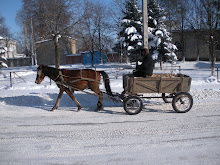To my absolute pleasure, this transition doesn't just affect my work here at site, but more and more I am taking on a consultancy role, helping other PCVs working with youth in Moldova. I am writing the chapters of a book every time I respond to emails from Zach and Cammy. They are both working with brand new youth groups, trying to identify missions, solve community problems, and keep kids motivated. I do not even begin to claim to have all the answers, but it is incredibly rewarding to be able to help them prevent mistakes that I made (or continue to make). Also, as a colleague doing similar work on another topic recently pointed out, I am finally given the avenue for organizing all my thoughts and experiences.
In a sense, this work is also why I was down south last week at Jen's site. Her partner has a group of youth that are too old to be direct beneficiaries of their children's center, but are quite interested in staying involved and developing new skills and understandings. I offer up the session we put together for them as an example of what it is I do in Moldova, it's been a while since I wrote about something other than birthday parties and my awesome host family.
The Afternoon:
1) Evaluation of the group's Halloween party the previous week: What was the best element? What was the weakest element? What will they change if they do it again next year? Since this was one of their first major events...what was it like to work as a team?
 2) Team-building activity: The human knot. Moldovans are not afraid of physical contact and have few personal space boundaries when compared with Americans, so it's an easy, and fun activity. What happened during the activity? Did they have to work as a team or could they succeed individually? Which was more important, listening or leading?
2) Team-building activity: The human knot. Moldovans are not afraid of physical contact and have few personal space boundaries when compared with Americans, so it's an easy, and fun activity. What happened during the activity? Did they have to work as a team or could they succeed individually? Which was more important, listening or leading?3) Building on their interests: The problem tree method (had I not prepared for this the day of, I probably would have chose a more asset-based activity, but I sadly fell for my old stand-by). After making a list of four youth problems in their village, the youth chose to attack teachers' vulgar vocabulary in the classroom.
This is the most original problem I've ever discussed with a group of youth in Moldova. I was thrilled that they didn't chose litter in the street or poverty. Though, I cannot comment on the actual extent of the bad language problem and it should be noted that eventually it was admitted that possibly pupils' behavior is a contributing factor of the vulgar vocabulary. Anyway, moving on...
 With the problem tree, we put the problem on the trunk, then address the visible consequences of the problem in the branches. This is the easiest part and usually takes only minutes to complete. Then, we move back to the bottom of the tree and identify the causes, or "roots" of the problem. This takes longer and just like always, the girls in this group were not all in agreement about the cause of the problem.
With the problem tree, we put the problem on the trunk, then address the visible consequences of the problem in the branches. This is the easiest part and usually takes only minutes to complete. Then, we move back to the bottom of the tree and identify the causes, or "roots" of the problem. This takes longer and just like always, the girls in this group were not all in agreement about the cause of the problem. 4) Identifying solutions: Once our tree was developed enough, and the youth were focused again on the causes of the problem, we began to identify possible solutions. This is as far as I was able to lead them during this session, but next time they meet, the director of this center will continue with them to analyze the strengths, weaknesses, opportunities, and threats (SWOT) of their two proposed solutions: A) Writing a letter to the school director and B) Doing a pupil's campaign for good classroom behavior and teacher appreciation activities. I wish them the best of luck and can't wait to hear how it goes!





























No comments:
Post a Comment